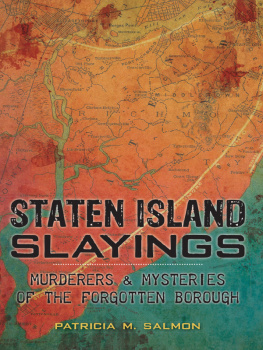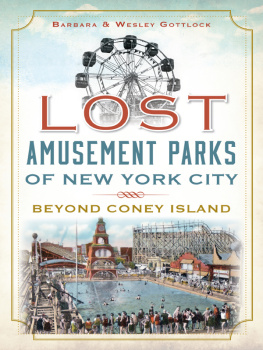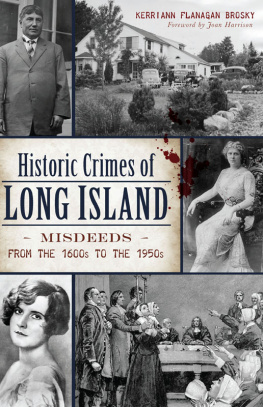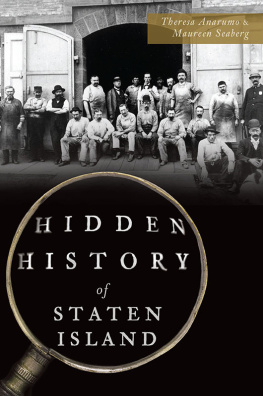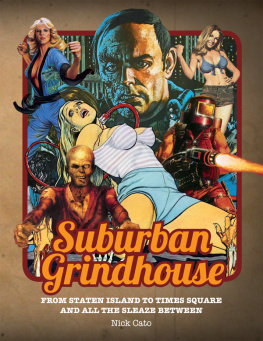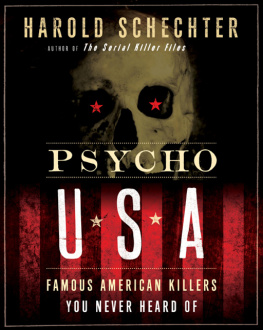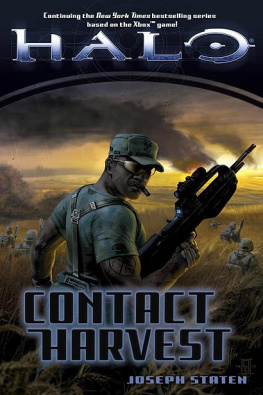

Published by The History Press
Charleston, SC 29403
www.historypress.net
Copyright 2014 by Patricia M. Salmon
All rights reserved
First published 2014
e-book edition 2014
ISBN 978.1.62585.281.6
Library of Congress CIP data applied for.
print edition ISBN 978.1.62619.755.8
Notice: The information in this book is true and complete to the best of our knowledge. It is offered without guarantee on the part of the author or The History Press. The author and The History Press disclaim all liability in connection with the use of this book.
All rights reserved. No part of this book may be reproduced or transmitted in any form whatsoever without prior written permission from the publisher except in the case of brief quotations embodied in critical articles and reviews.
For Cheryl Criaris Bontales, a genuine Staten Island collector, historian and lifelong friend. We were fortunate to grow up in a neighborhood surrounded by history and historians.
CONTENTS
ACKNOWLEDGEMENTS
Sincere thanks to Barbara MacDonald Hemedinger, Megan Beck, Dawn Daniels, Michael Fressola, Fred DeLise, Friends of Abandoned Cemeteries of Staten Island, Ciro Galeno, Beth Gorrie, Dr. Thomas Matteo, the Noble Maritime Collection, Lynn Rogers, Staten Island OutLOUD and Erin Urban.
INTRODUCTION
Documentation of criminal activities of the past is certainly popular with the reading public. For this reason, a second volume focusing on Staten Island murders has been researched and presented with the hope that readers will continue to consider and contemplate the events of years gone by. Most importantly, it is hoped that these chronicles will enable all to remember the victims, especially those whose murders have never been solved. There are, unfortunately, many who fall within the boundaries of this category.
One killing that was documented and solved was preserved in not one, but two, Boston newspapers. While not surviving in any Staten Island newspapers, Kenneth Scott described it in a volume of The Staten Island Historian published by the Staten Island Historical Society in 1953. This horrific event took place in 1744, at a time when Staten Island was a rural enclave with farms spread sporadically across the island. Many individuals who received colonial land grants lived on properties comprising anywhere from several dozen to several thousand acres. Of course, the average farmer owned a more modest plot. These men were generally experts, or at least knowledgeable, on matters of naturally occurring flora, since they did not want their valuable farm animals nibbling on the toxic foliage that lined the borders of their agricultural property. In 1744, there was a Staten Island inhabitant who was learned in such matters. Married for only five months, he soon grew tired of his wife. As a matter of fact, he grew very tired of her. In late January or February of that year, this particularly weary fellow went afield to gather some herbs. Knowingly, he picked the most poisonous species he could locate. The devious collector brought the herbs home, handed them to his unsuspecting wife and told her to stuff a leg of veal with his fresh harvest.
NOTES TO THE READER
The county of Richmond was established by the English governor Thomas Dongan on November 1, 1863. It was one of the original ten counties of what was then the province of New York. In 1788, Richmond was divided into the townships of Northfield, Westfield, Castleton and Southfield. In 1860, the new township of Middletown was carved out of portions of Castleton and Southfield. When the city of New York was consolidated in 1898, the resulting five boroughs included the official borough of Richmond. Prior to this occurrence, the island was generally referred to as the county of Richmond or Richmond County, with the old Dutch name of Staten Island sometimes used as well. In 1975, the official name was changed to Staten Island. Even so, Richmond and Staten Island are used interchangeablyofficially and unofficiallywith Staten Island being the more popular of the two unofficially.
The nineteenth and early twentieth centuries saw much confusion concerning streets on Staten Island, as many of their names were used multiple times on the island. In the early 1900s, a committee was formed to rectify this confusion. (One member of this committee was naturalist/historian William T. Davis.) The work of these men resulted in many street name conversions in 1909. In 1915 and again around 1930, additional street names were amended. For this reason, there are streets documented in this book and others that no longer exist. Where possible, the current name has been included. It is also important for the reader to know that the Richmond Turnpike is now called Victory Boulevard. This name change occurred as a result of the victory realized at the close of World War I. In addition, the community we now refer to as Richmond Town was historically known simply as Richmond. Of major importance to readers and researchers is the fact that house and business address numbers were also altered. This process is said to have occurred around 1917.
Unfortunately, several of these chapters demonstrate the prejudice that is often unleashed on ethnic groups and women. They are distressing but true representations of the thought patterns of many individuals and groupsnow and in the past. The prejudice and stereotyping relayed in some of these chapters is in no way representative of the authors beliefs or feelings and have been left intact, as they might have affected the event(s) described herein. They are important components of the accounts as they unfolded, and their removal would result in historical inaccuracy.
CHAPTER 1
FASCINATING DISCLOSURES
RewardMrs. Eliza Brannan has been missing from this city since last Tuesday afternoon at 3 oclock (July 20) when she left Third Street on her way to the steamboat Thomas HuntShe was in appearance between 25 and 30 years of age, of medium size, light hair, blue eyes, low forehead, was dressed in mourning black hat and veil
Mrs. Brannan had simply disappeared into the vapors of an unremarkable summer afternoon. No one knew where she was. If someone, anyone, could provide information leading to the establishment of her whereabouts, they would receive what was then a vast sum$200. Two weeks later, the reward more than doubled to $500! To be compensated, the collector was advised to proceed to the office of Dr. Charles H. Crane at the U.S. Army Medical Purveyors Office, 110 Grand Street, Manhattan. Dr. Crane was Mrs. Brannans brother. Both were the offspring of Colonel Ichabod Crane. Indeed, the late Colonel Crane was a very real person. When Washington Irving met Ichabod Crane at Sacketts Harbor, New York, in 1814, he was fascinated with the mans name and determined to use it in his literary endeavors, hence the famous character in the famous short story The Legend of Sleepy Hollow. It is important to note that the schoolteacher and the real Ichabod Crane have absolutely nothing in common other than their name.
Born in Elizabeth, New Jersey, on July 18, 1787, the real Ichabod Crane was a graduate of West Point. Eventually, he climbed through army ranks and was appointed a colonel in the First United States Artillery. After the close of the Mexican-American War, sometime around 1850, Crane purchased a farm on the Richmond Turnpike (now Victory Boulevard) near Signs Road in the Chelsea Heights section of Staten Island. Akin to a social headquarters for visiting army officers, Crane did not enjoy this new homestead for long, as he passed into the next life on October 5, 1857. The colonel was buried with strict military honors at the Springville Cemetery, now part of the Asbury Methodist Episcopal Cemetery on Richmond Avenue in New Springville. (A unique obelisk monument to his memory is visible at the burial ground today.) General Winfield Scott was just one of the many esteemed members of the armed forces present at his burial.
Next page
